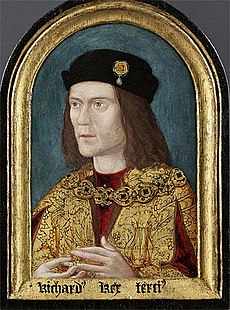 I imagine some of our readers already know this, but here’s a follow up on a story we covered earlier this year. In February, archaeologists confirmed that they had discovered the remains of King Richard III beneath a parking lot in Leicester. Richard died in battle at Bosworth Field in August 1485; the Tudor victors gave him a rather unceremonious burial in what was then a local abbey. Richard will now be re-interred in Leicester’s Anglican cathedral, most likely next May. Back in February, some Catholics objected that Richard, who was Catholic, should by rights be buried in a Catholic ceremony in a Catholic sanctuary. According to the Law and Religion UK blog, however, the Catholic Church in the UK will not insist. The Catholic Bishop of Nottingham states:
I imagine some of our readers already know this, but here’s a follow up on a story we covered earlier this year. In February, archaeologists confirmed that they had discovered the remains of King Richard III beneath a parking lot in Leicester. Richard died in battle at Bosworth Field in August 1485; the Tudor victors gave him a rather unceremonious burial in what was then a local abbey. Richard will now be re-interred in Leicester’s Anglican cathedral, most likely next May. Back in February, some Catholics objected that Richard, who was Catholic, should by rights be buried in a Catholic ceremony in a Catholic sanctuary. According to the Law and Religion UK blog, however, the Catholic Church in the UK will not insist. The Catholic Bishop of Nottingham states:
The Bishop is pleased that the body of King Richard III has been found under the site of Greyfriars Church in Leicester, in which it was buried following the Battle of Bosworth in 1485, and that it will be reinterred with dignity in the city where he has lain for over five hundred years. Richard III was one of the last Catholic monarchs of England and his death was a decisive moment in British history, but the ultimate decision as to what form the interment takes lies with the Government and the Church of England, since he will be buried in Leicester Cathedral. In accordance with long-established ecumenical practice, Bishop Malcolm will be happy to take part in any form of ceremony which takes place to mark his final burial.
A little hard to follow, but the meaning seems to be, as the government has already decided to bury Richard in the Church of England, the government can also decide on the ceremony. So that’s that. The event will surely be less tense than Richard’s coronation. But will they serve strawberries at the reception?
Presumably the form of service remains to be decided.
When the sailors who drowned in 1545 when the “Mary Rose” overturned and sank were reburied, because they died after the break with Rome but before the publication of the 1549 Book of Common Prayer the burial service and requiem (at Portsmouth Cathedral) were conducted in accordance with the Sarum Rite and sung in Latin to a setting by John Taverner – who also died in 1545. The then Provost of Portsmouth, David Stancliffe (later Bishop of Salisbury) was and is a noted liturgist; and in order to get things exactly right he went so far as to borrow vestments in the correct Sarum liturgical colours from the Cathedral of the Advent, Birmingham, Alabama.
He should not be buryed on church ground at all.he was responsible for the murder of the two princes..if you know your history you should know this ??